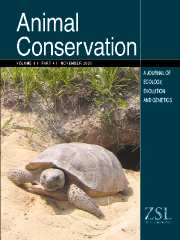Crossref Citations
This article has been cited by the following publications. This list is generated based on data provided by
Crossref.
Frankham, Richard
Ballou, Jonathan D.
Briscoe, David A.
and
McInnes, Karina H.
2004.
A Primer of Conservation Genetics.
Hedges, Simon
2006.
Biology, Medicine, and Surgery of Elephants.
p.
475.
Corlett, Richard T.
2007.
The Impact of Hunting on the Mammalian Fauna of Tropical Asian Forests.
Biotropica,
Vol. 39,
Issue. 3,
p.
292.
Marealle, Wilfred N.
Foss⊘y, Frode
Holmern, Tomas
Stokke, Bård G.
and
R⊘skaft, Eivin
2010.
Does illegal hunting skew Serengeti wildlife sex ratios?.
Wildlife Biology,
Vol. 16,
Issue. 4,
p.
419.
Velho, Nandini
Karanth, Krithi K.
and
Laurance, William F.
2012.
Hunting: A serious and understudied threat in India, a globally significant conservation region.
Biological Conservation,
Vol. 148,
Issue. 1,
p.
210.
Haines, Aaron M.
Elledge, David
Wilsing, Lucas K.
Grabe, Matt
Barske, Michael D.
Burke, Nolan
and
Webb, Stephen L.
2012.
Spatially explicit analysis of poaching activity as a conservation management tool.
Wildlife Society Bulletin,
Vol. 36,
Issue. 4,
p.
685.
Ghosal, Ratna
Kalaivanan, N.
Sukumar, Raman
and
Seshagiri, Polani B.
2012.
Assessment of estrus cyclicity in the Asian elephant (Elephas maximus) by measurement of fecal progesterone metabolite 5α-P-3OH, using a non-invasive assay.
General and Comparative Endocrinology,
Vol. 175,
Issue. 1,
p.
100.
Kumara, H. N.
Rathnakumar, S.
Kumar, M. Ananda
and
Singh, M.
2012.
Estimating Asian Elephant, Elephas Maximus, Density Through Distance Sampling in the Tropical Forests of Biligiri Rangaswamy Temple Tiger Reserve, India.
Tropical Conservation Science,
Vol. 5,
Issue. 2,
p.
163.
Chelliah, Karpagam
Bukka, Harshvardhan
and
Sukumar, Raman
2013.
Modeling harvest rates and numbers from age and sex ratios: A demonstration for elephant populations.
Biological Conservation,
Vol. 165,
Issue. ,
p.
54.
Mondol, Samrat
Mailand, Celia R.
and
Wasser, Samuel K.
2014.
Male biased sex ratio of poached elephants is negatively related to poaching intensity over time.
Conservation Genetics,
Vol. 15,
Issue. 5,
p.
1259.
Goswami, Varun R.
Vasudev, Divya
and
Oli, Madan K.
2014.
The importance of conflict-induced mortality for conservation planning in areas of human–elephant co-occurrence.
Biological Conservation,
Vol. 176,
Issue. ,
p.
191.
Mondol, Samrat
Sridhar, Vanjulavalli
Yadav, Prasanjeet
Gubbi, Sanjay
and
Ramakrishnan, Uma
2015.
Tracing the geographic origin of traded leopard body parts in the indian subcontinent with DNA‐based assignment tests.
Conservation Biology,
Vol. 29,
Issue. 2,
p.
556.
Puyravaud, Jean Philippe
Davidar, Priya
Srivastava, Rajeev K.
and
Wright, Belinda
2017.
Modelling harvest of Asian elephantsElephas maximuson the basis of faulty assumptions promotes inappropriate management solutions.
Oryx,
Vol. 51,
Issue. 3,
p.
506.
Kumar, Ved Prakash
Shrivastwa, Anupam
Nigam, Parag
Kumar, Dhyanendra
and
Goyal, Surendra Prakash
2017.
Genetic characterization of wild swamp deer populations:
ex situ
conservation and forensics implications
.
Mitochondrial DNA Part A,
Vol. 28,
Issue. 6,
p.
965.
Liu, Peng
Wen, Hui
Harich, Franziska K.
He, Changhuan
Wang, Lanxin
Guo, Xianming
Zhao, Jianwei
Luo, Aidong
Yang, Hongpei
Sun, Xiao
Yu, Yang
Zheng, Shaobo
Guo, Jing
Li, Li
and
Zhang, Li
2017.
Conflict between conservation and development: cash forest encroachment in Asian elephant distributions.
Scientific Reports,
Vol. 7,
Issue. 1,
Bansiddhi, Pakkanut
Brown, Janine L.
Thitaram, Chatchote
Punyapornwithaya, Veerasak
Somgird, Chaleamchat
Edwards, Katie L.
and
Nganvongpanit, Korakot
2018.
Changing trends in elephant camp management in northern Thailand and implications for welfare.
PeerJ,
Vol. 6,
Issue. ,
p.
e5996.
Menon, V.
and
Tiwari, S. KR.
2019.
Population status of Asian elephantsElephas maximusand key threats.
International Zoo Yearbook,
Vol. 53,
Issue. 1,
p.
17.
Nasoori, Alireza
2020.
Tusks, the extra-oral teeth.
Archives of Oral Biology,
Vol. 117,
Issue. ,
p.
104835.
Jiang, Feng
Song, Pengfei
Zhang, Jingjie
Cai, Zhenyuan
Chi, Xiangwen
Gao, Hongmei
Qin, Wen
Li, Shengqing
and
Zhang, Tongzuo
2020.
Assessing the impact of climate change on the spatio-temporal distribution of foot-and-mouth disease risk for elephants.
Global Ecology and Conservation,
Vol. 23,
Issue. ,
p.
e01176.
Sharma, Purushottam
Panthi, Saroj
Yadav, Subodh Kumar
Bhatta, Manoj
Karki, Ajay
Duncan, Tom
Poudel, Megharaj
and
Acharya, Krishna Prasad
2020.
Suitable habitat of wild Asian elephant in Western Terai of Nepal.
Ecology and Evolution,
Vol. 10,
Issue. 12,
p.
6112.


